Untold Tales: The Spring That Wasn't
This was Vince Carter, the eight-time All-Star, the pioneer of the forearm dunk, the man who made hoops cool in Canada. He deserved better than a hastily arranged uncontested three-pointer in the closing seconds of a defeat in a uniform few will remember him in... didn’t he?
He deserved a fitting send-off—a highlight montage, a chance to address the crowd, a prolonged standing O, maybe a rocking chair—before his final game, which was to be in Atlanta on April 15. And it’s not just the fans who missed out on a chance to honor a man who has influenced a generation of players. When Trae Young was struggling last year as a rookie, it was Carter, whose locker was next to his on the road, who provided guidance. “He was always there to talk to and let me know to be patient and trust the work I was putting in,” Young says. “He’s like a big brother.”
He deserved that one final trip to Toronto, originally scheduled for April 10, to properly exchange goodbyes with a city where he spent his first six and a half seasons. “That would have been nice,” Carter concedes. “But I promise you, I’m good with it.”
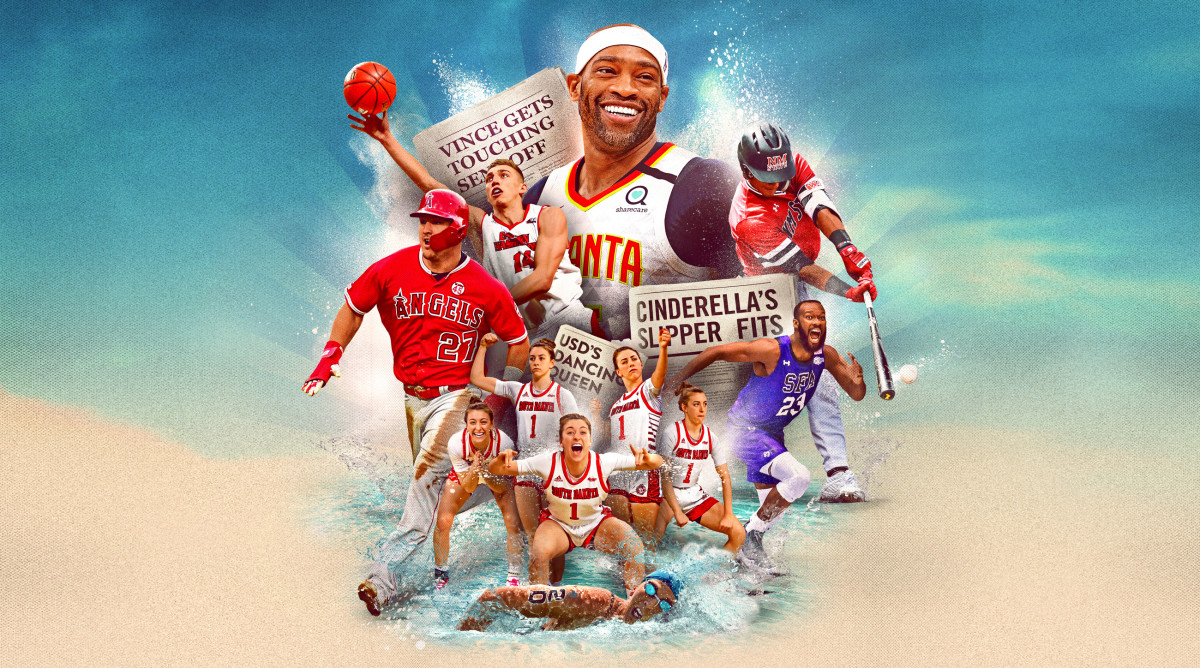
Vincefest is one of the many events that fans will be deprived of seeing—and one of the biggest stories we will be deprived of telling because of the COVID-19 pandemic. But Carter is at peace with the end, perhaps because it came long after he expected it to. Twenty-two seasons? The springy, 21-year-old, 6' 6" swingman from North Carolina who landed in Toronto in 1998–99 wanted a long career, not a record-breaking one, something similar to the runs childhood heroes Michael Jordan (15 seasons), Larry Bird (13) and Magic Johnson (13) put together. “I said if I can make it to 15 years, playing at least a year longer than some of the greatest of all time that played the game, I’m doing something,” says Carter. “I’ve accomplished something.”
A 15-year career would have ended in Dallas, in 2012–13. Carter wasn’t Carter with the Mavericks, but he was still pretty good. He averaged double digits. He connected on 40.6% of his threes. He picked up a couple of sixth man award votes, successfully transitioning to full-time reserve. He could have exited on top. But Carter wasn’t ready to quit. His body was strong. His desire to keep playing was even stronger. After ’13–14, he told himself: Two more years. He played 81 games that season; he tacked on 66 the year after. O.K., Carter said. Two more years. By 2017–18, Carter wondered, Am I staying too long? He called former Raptors teammate Tracy McGrady, who retired in 2013 after 16 seasons. When it’s time, McGrady told him, you will just know. After that, Carter stopped setting end dates.
Carter’s durability is as improbable as it is impressive. He went from picking up All-NBA honors in his second and third seasons to being dealt to the Nets for spare parts midway through his seventh. Knee and hamstring problems saw him branded as injury-prone, derided as soft.
There are layers to Carter’s longevity. There is the physical, the ability to keep his body running at a level that allowed him to compete against players half his age, and there’s the mental aspect. “It’s just finding the motivation,” says Carter. “Some days I could walk by the weight room and just be like, ‘Eh, not today.’ In the evening, you kind of feel guilty about it. You tell yourself to get it in gear.”
As his athleticism faded, Carter learned not to rely on it. “The thing I understood was I was able to look in the mirror and say, ‘Hey, this Plan A isn’t going to work all the time. So make sure you have a Plan B to put the ball in the hole,’ ” says Carter. “Even at my peak of being superathletic, I still wanted to outsmart people. And I learned quickly playing against the Knicks, my first playoff run [a first-round sweep in 2000], it’s not about just being athletic. You have to learn how to outsmart teams.”
Make a list of former All-NBA players who made the transition to role players. There’s Carter and . . . well, not much else. There wasn’t an aha! moment, Carter says, no epiphany. Just a quiet understanding that there was less value in starting games than there was in finishing them. To prepare, Carter studied Vinnie Johnson, a super sub for the Pistons in the 1980s, devouring hours of the Microwave’s highlights on YouTube. “As a starter, you can kind of work your way into the game,” says Carter. “As a reserve, you have to be ready to go as soon as you walk in. You look at the flow of the game, instead of trying to create the flow of the game.”
Kobe Bryant spent 20 years with the Lakers, and Dirk Nowitzki 21 with the Mavs. Carter wore eight uniforms, though it’s the last few that were the most curious. In the twilight of his career he could have signed with a contender. Instead, he went to Sacramento and Atlanta, twice, trading a chance for a title for a chance to play. “I had some [contenders] that were offering the opportunities,” Carter says. “They were saying, ‘We can’t guarantee [minutes].’ And I don’t expect anyone to guarantee me minutes. But to say, ‘We don’t think there’s any minutes, but you would help our team as far as just wisdom.’ That’s something I didn’t want to do. I just wanted to play. I could lend my wisdom and be an unbelievable mentor for a guy. But sometimes showing is better than telling.”
Carter declared his intention to retire last spring, yet in the early months of the season, he had doubts. Then, in December, a chance encounter with Bryant, in Brooklyn. The two former rivals embraced. Carter asked Bryant about retirement. Bryant told Carter it was the happiest he had ever been. A month later, Carter passed Nowitzki for third on the all-time games-played list. Nowitzki texted him and told him, on the subject of retirement, Man, you’re going to love it. “It was reassuring,” says Carter. “Comforting. Those are the guys that I wanted to talk to and hear from.”
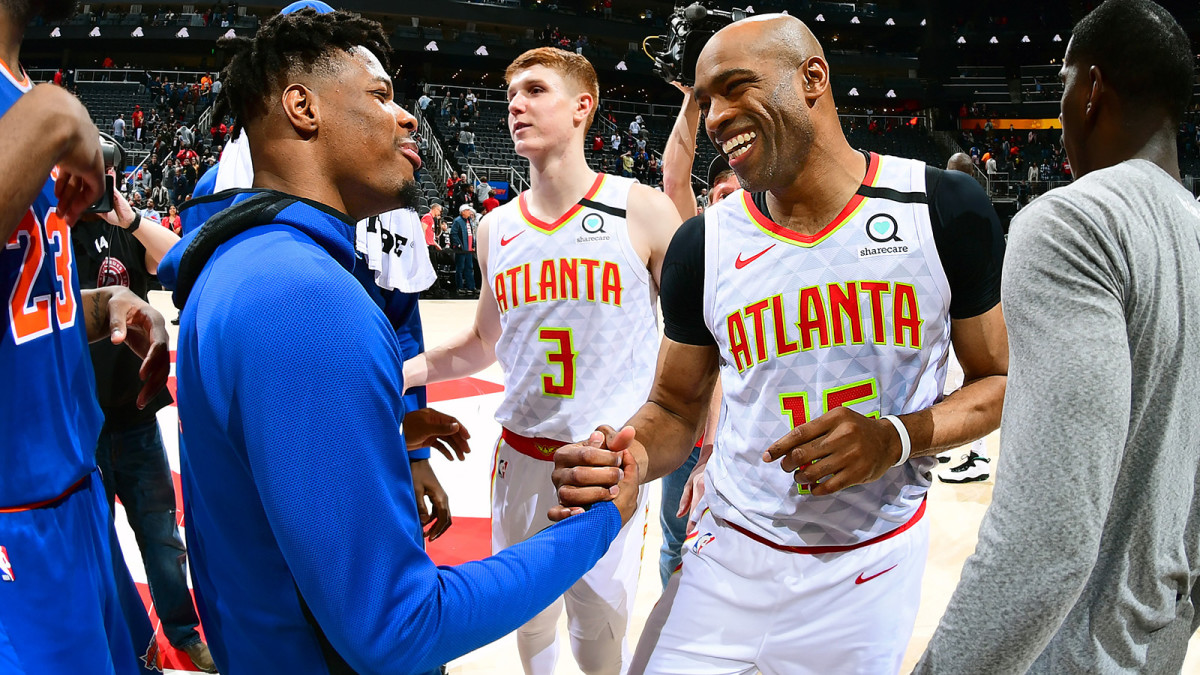
Which is why, for Carter, having his final NBA moment with the Hawks, against the Knicks in a half-empty State Farm Arena doesn’t feel like a letdown. Just before the third quarter, word filtered down to Atlanta’s bench. Something happened with the Jazz. Gobert, they think. In the fourth, the news broke: The NBA had suspended the season. In overtime, a “We want Vince” chant began in the stands. Says Carter, “I think they had a better understanding of what was going on than we did.”
With 19.5 seconds left, Hawks coach Lloyd Pierce made eye contact with Carter. Carter looked away. “I didn’t want to go in,” he said. The chant continued. Pierce yelled for Carter. “That’s when it kind of hit me,” says Carter. He took a spot on the free throw line next to RJ Barrett, New York’s 19-year-old rookie guard. On Atlanta’s final possession Carter took a dribble handoff from Young and lined up a top-of-the-key three. In his 1,541st game, playing his 46,367th minute, Carter scored the last of his 25,728 points, knocking in his 2,290th three. As the NBA froze, a legend quietly said goodbye. Not ideal, maybe, but says Carter, “I ended on a pretty cool note.” —Chris Mannix
Verducci: Mike Trout, MLB Face Haunting Thought of Lost Season
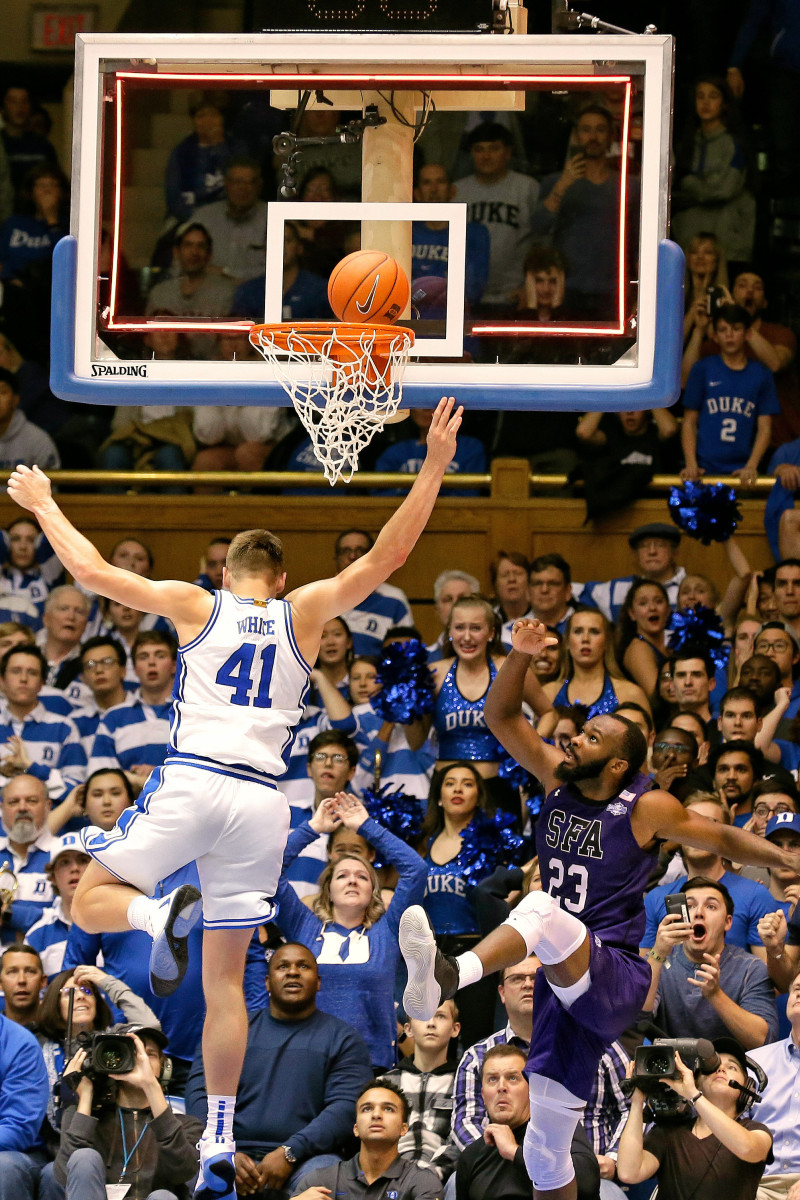
DEVIL DOWN
Racing against time to deliver a staggering upset, Nathan Bain stole a quick look at the game clock as he rushed downcourt. Could he get there?
“I knew I had to get up on my horse,” he says.
The Stephen F. Austin senior forward found himself in an unimaginable position—on an overtime breakaway to beat No. 1 Duke at Cameron Indoor Stadium. The play unfolded the way many had in the Lumberjacks’ 28–3 season: through sheer effort. Guard Roti Ware had made a diving deflection of a pass in the lane, then teammate Gavin Kensmil hit the deck to secure the loose ball. Kensmil made eye contact with the 6' 6" Bain and passed it ahead to him with about 80 feet to cover and 4.3 seconds left.
Bain had already covered a lot of ground just to be in this position. He came from the Bahamas to the U.S., did a year of prep school, redshirted a season on campus in Nacogdoches, Texas, and endured one injury after another—five surgeries in all. And while he was gritting his way through his senior year, he worried about his family back home.
In September, Hurricane Dorian had almost completely destroyed the church in Freeport run by Bain’s father, as well as the family home. The school set up a GoFundMe page for the Bains. Donations were around $2,000 when the Lumberjacks visited Cameron Indoor.
Then something beautiful happened. Bain with the ball, game on the line, clear path to the basket—if he could beat the clock.
“I don’t know why I thought I had enough time,” he said, “but it turned out I did.”
Bain kissed a right-handed layup off the glass just before time expired and, like that, an anonymous fifth-year senior at a Southland Conference school became a national sensation, SFA 85, Duke 83.
Through tears, Bain and his coach, Kyle Keller, made mention in the postgame interview of the family’s circumstances. Links to the GoFundMe page were circulated. Donations poured in from everywhere—from North Carolina and Kentucky supporters giddy at Duke’s comeuppance, but also from Blue Devils fans themselves and others who were simply touched by Bain’s hardship. In a few days, $2,000 became $151,000.
Today, repairs to the church and home are coming along nicely. Things
are looking up,” Bain says.
Stephen F. Austin never got the chance to play in the conference tournament, where it would have been the prohibitive favorite after going 19–1 during the league’s regular season. The Lumberjacks never got to test themselves in the NCAA tournament, to see if they could have
been this year’s Loyola-Chicago.
But they did have their One Shining Moment in Durham, the biggest upset of the season, with a winning basket that reverberated all the way to the Caribbean.
“He has always played for Stephen F. Austin, not for Nate Bain,” Keller says now. “I think it was very fitting that he made that last basket.”—Pat Forde
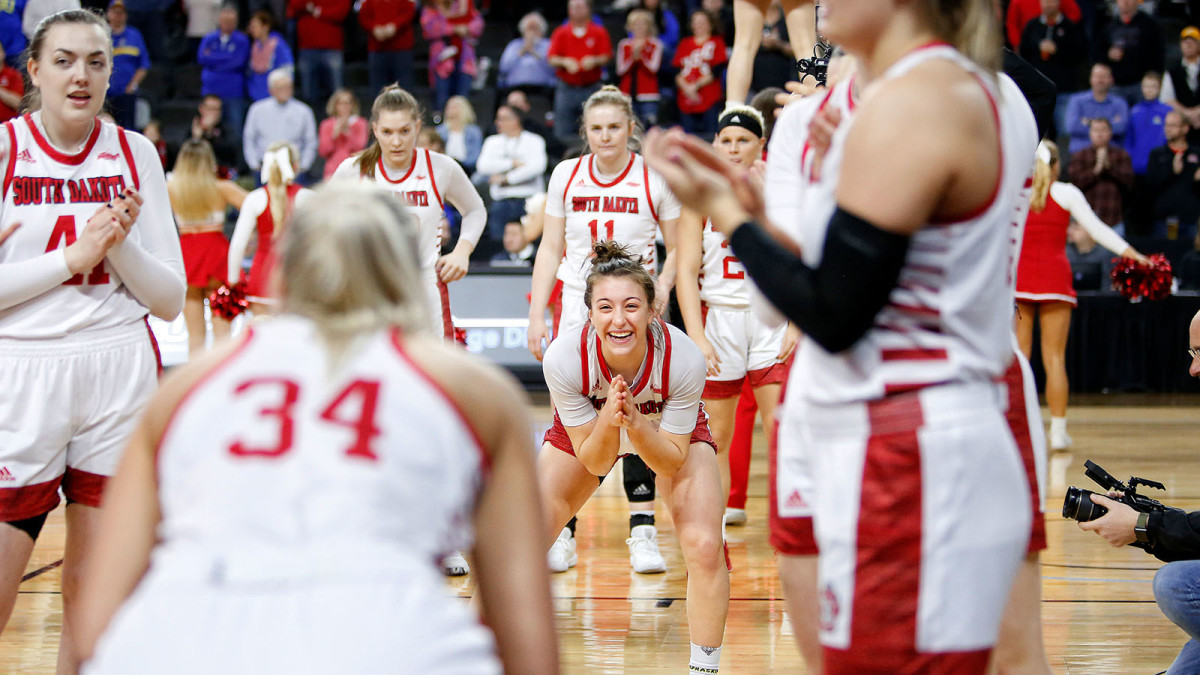
Wily Coyote
If there’s one thing that’s as beloved in college hoops as a Cinderella, it’s a bench mob. Think Monmouth’s reserves re-creating Michelangelo’s Creation of Adam by lifting a backup guard in the air to play the part of God, or Nebraska’s subs celebrating a big shot by mimicking a bobsled run.
This year’s breakout bench was set to be the South Dakota women—but unlike those Hawks and Cornhuskers, these Coyotes had a chance to do some serious damage in their tournament as well. Vermillion, S.D., might not top many hoops-hotbed lists, but USD finished its season 30–2, including 16–0 in the Summit League. After winning the conference tournament, the Coyotes were ranked 11th in the country thanks to a high-octane offense that drew on the energy of its reserves, led by junior Claudia Kunzer.
The 5' 6" guard oozes positivity, not to mention fun. She has been refining her sideline celebrations since arriving on campus from Bartlett, Ill., three years ago. When senior Ciara Duffy hit a three-pointer—and the 2019–20 conference player of the year hit a ton of them—Kunzer would throw up both hands, crouch a bit and wiggle her knees, evoking the end zone dances of just about every 1970s NFL player. On the other hand, when low-key guard Chloe Lamb dropped a long-range shot, there was a more muted celebration: three fingers on one hand coolly tapping the opposite forearm. “Ice in the veins, Chloe,” says Kunzer. “Ice in the veins.”
She also has handshakes for all starters when they’re announced, including a three-point TSA-style pat down of Duffy and an indescribably complex routine with Lamb that they do every night before bed.
“It really keeps me involved in the game,” says Kunzer, who scored 1.9 points in nine minutes per game. “And it’s really fun for me and my other teammates who are on the bench. We’re doing something, and we feel as involved in the game as if we were playing. It makes us all ready whenever our name’s called.”
Kunzer could have a bright career as a hype woman or a life coach, but her plan is to become a nurse, so she appreciates the severity of the pandemic that caused the NCAA tournament to be canceled. But that doesn’t make it easier to accept. Next season Duffy will have graduated, meaning the bench will need to provide more than elaborate choreography. And Kunzer is ready.
“We were so good this year, and I had 100% confidence we could have made a run,” Kunzer says. “And yes, we are losing four amazing seniors. But it makes me excited, because it’s our time. It’s my class’s time. Because we didn’t get to show you guys what we can do this year, we’re going to be right back to do it next
year.” —Mark Bechtel
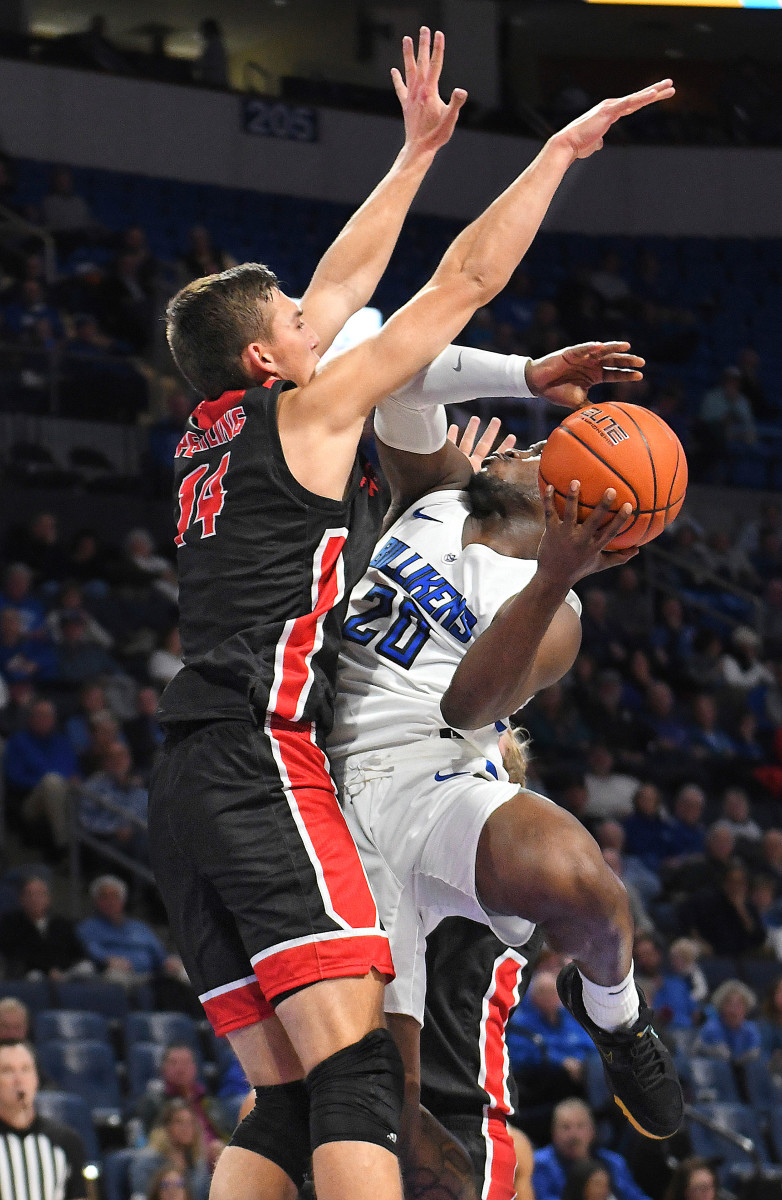
Aussie Ruled
Mason Peatling is a self-proclaimed late bloomer—and it didn’t help his college scholarship prospects that he lived on the opposite side of the planet from U.S. hoops recruiters. In fact, it was only by mistake that coaches from Eastern Washington found him while studying tape from an Australian club team. They were scouting another Aussie when a lanky, 6' 8" forward, just 17 years old, kept barging into the frame. “He’d throw his body against guys 50 pounds heavier,” says Eagles coach Shantay Legans. “You knew sooner or later he was going to be the big dog.”
In four years on campus, Peatling has earned a finance degree, completed master’s courses in business with a 4.0 GPA and, this spring, been named the Big Sky Player of the Year. The centerpiece of a team that went 23–8 and won the conference regular-season title, Peatling, 23, averaged 17.2 points and 9.1 rebounds per game. In December he set a league record with 54 points in a 146–89 win over Multnomah.
Peatling is the kind of player who might have caught the attention of March Madness viewers this year—that mid-major standout with a quirky story who dances his way to stardom. He has a deft touch around the rim and, as he puts it, “annoys people on defense.” His teammates call him the General; Legans refers to him as a “cyborg.”
To Laura Peatling, he’s hubby. Before moving to Cheney, Wash., Mason married the sister of a club teammate. Laura came with him, along with their Havanese, Bonnie. “I had it all figured out,” a chuckling Mason says. “It was a big commitment but I wouldn’t have seen it going any other way.”
Because of the pandemic, the Big Sky canceled its tournament two hours before Eastern Washington played its opening game; the NCAA tourney was called off 90 minutes later. Just like that, Peatling’s college career was over.
“Obviously disappointed in the way it ended,” Peatling says, “but can’t take away what we did in the regular season.”
Peatling plans to join the NBL, the Australian pro league (where NBA prospects LaMelo Ball and RJ Hampton played this season). Within two weeks of the season’s end, Peatling and Laura made the hellish, three-flight journey back to Melbourne with Bonnie. Then they had to quarantine for 14 days in Laura’s parents’ home.
Now that that’s over, Mason will begin training at a nearby park and hopefully be hooping again soon. “Assuming,” he says, “the world goes back to normal.” —Ross Dellenger
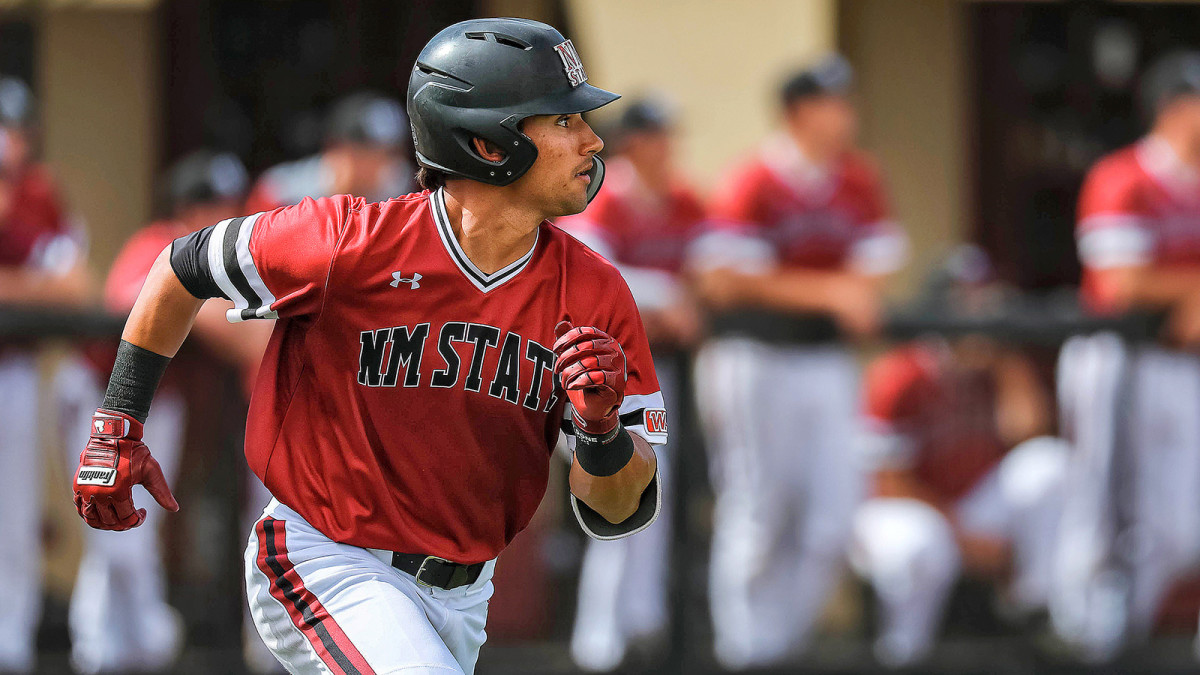
Shifting Focus
If he had known he’d never get another chance, Nick Gonzales would have said goodbye to the field. He would have gathered his teammates and snuck into New Mexico State’s Presley Askew Field, the same way he did so many times during his two and a half years there: stroll past the main entrance, bank left onto a path, hop the railing, scuttle behind the bleachers, traipse through the bullpen, reach the door to the trainers' office and key in the code. They would have tossed each other batting practice, line drives and jokes slicing through the night air. He would have retreated to the top of the grandstand, behind home plate, just to watch.
“Yeah,” he says now, savoring the image from his quiet house near a quiet campus in a quiet country. “I think that would have been good.”
Gonzales was leading the NCAA in home runs (12) and RBIs (36) when his junior season evaporated in early March after just 16 games. He will likely be a top-five pick in this year’s MLB draft, whenever it occurs. His baseball career is just getting started. But his college baseball career is over.
That reality didn’t hit him right away. On March 11, he was packing for a series at San Diego State when assistant coach Mike Pritchard texted him that the games were canceled due to the rapid spread of the coronavirus. It’s just a precaution, coaches told players the next day. An hour later, they were chatting in the clubhouse when ESPN flashed an NCAA statement canceling all spring championships.
Gonzales mourned the lost season and grieved for the seniors, but immediately pivoted to preparing for the draft. He had already transformed himself into a top prospect through tireless work. He had D-I scholarship offers coming out of Cienega (Ariz.) High, but he wanted to play close to home in Vail so his family could watch his games. Arizona and Arizona State showed no interest. He decided to walk on to the team at New Mexico State. “We’ll just have to pay for one year,” he assured his parents. He spent every spare minute in the batting cage. That spring, he was Western Athletic Conference Freshman of the Year.
Using a friend’s private batting cage and weight room nearby, the 5' 10", 190-pound Gonzales is now working to improve his strength and his defense at shortstop, where he hopes to stick in the majors. If anything, he told himself, the pandemic sets him up better for the next stage: He can now train without risking injury during the Aggies’ season. He locked his eyes on the future: “I felt like I was in a good position to move to the next level and move forward.”
But two weeks later, he was cleaning his apartment when he came across a stack of laminated certificates: 2018 First Team All-Conference, 2018 Western Athletic Conference Freshman of the Year, 2019 First Team All-Conference, 2019 First Team Academic All-Conference. He eyed the ring the school awarded the team for making an NCAA regional in ’18 and the plaque that congratulated him on his ’19 NCAA batting title (.432). This year, he imagined a hard-fought junior season, maybe one culminating in another trip to a regional. He wanted to leave his mark.
“It’s just an empty feeling,” he says.
Gonzales played a couple of Wiffle ball games with his teammates in those first days after everything was canceled, but one by one, they all went home. He stayed; all the facilities in Vail are now closed. He is genuinely excited for the time ahead—major league glory is his ultimate goal, after all. But college glory was the penultimate one. —Stephanie Apstein
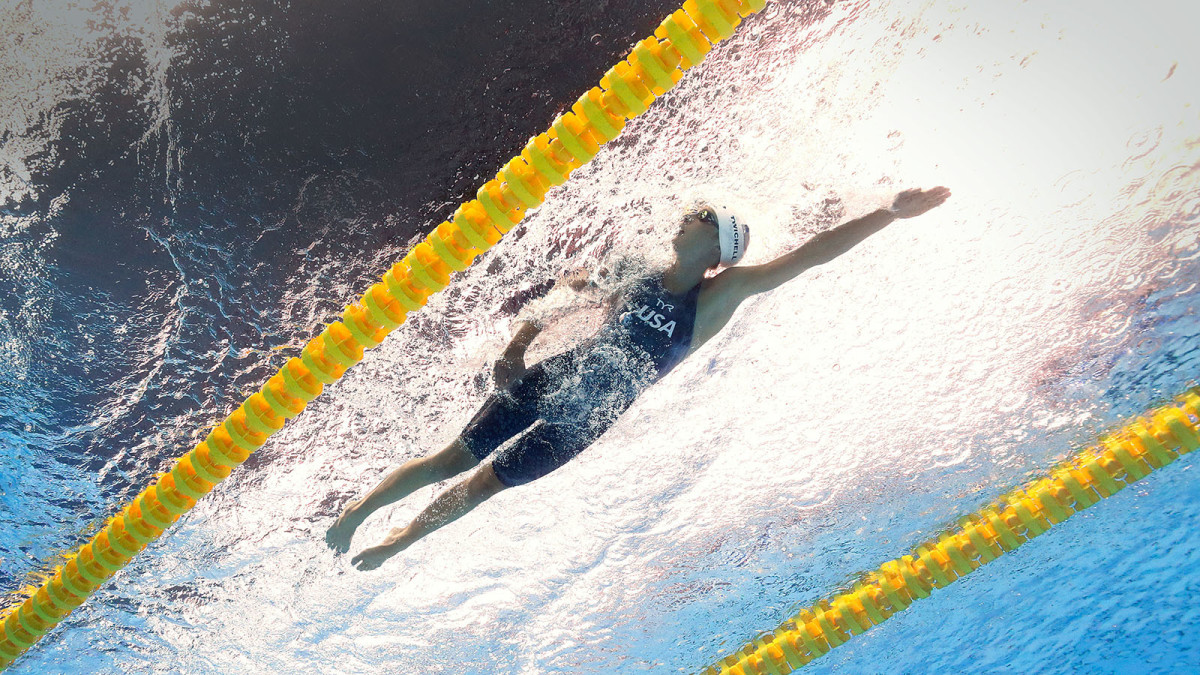
Water Wait
Ashley Twichell knew not to panic. But with about 800 meters remaining in last July’s 10K open-water world championship race in Yeosu, South Korea, she was in 14th place, in danger of missing the Olympics for the fourth straight cycle. Stroking through the city’s bay, Twichell told herself that whether or not she placed in the top 10—thereby qualifying for the Tokyo Games—she had given her all.
The final 10 minutes felt like an eternity for her father, Terry, watching from the stands. “Not again,” he thought. The leaderboard didn’t update until the race ended, but down the stretch, Ashley had surged into sixth. With a time of 1:54:50.5, she’d qualified.
“It’s obviously been a really long journey, so it was a lot of pressure off my shoulders,” she says.
Twichell turns 31 in June and, had the Games proceeded as scheduled, would have been the U.S.’s oldest rookie Olympic swimmer since 1908. Her qualification will still count next year, when, at 32, she will be the second-oldest female U.S. Olympic swimmer ever. (Dara Torres was 41 when she competed in the 2008 Games, where she won three silver medals.)
“I don’t feel like I’m that old,” Twichell says, “and I’m still improving.”
The youngest of four, Twichell says she could swim before she could walk. On trips to Florida as a teen, she would swim miles through the surf with her father and siblings, fighting fatigue and waving as she passed her dad.
At 18, she aimed to qualify for Beijing in the 400-meter freestyle but didn’t advance from her U.S. trials heat. In 2010, she tried open-water racing for the first time. “It went absolutely horribly,” she says. She finished next-to-last in the 10K U.S. championships and felt on the brink of hypothermia. Her mother raised skipping the 5K two days later. “But I knew if I didn’t do the 5K, I wouldn’t touch open water again,” Twichell says.
She improved quickly, but in 2012 missed qualifying by seconds. “That was when the fire was really lit in me to make an Olympic team,” she says. But a 2014 right shoulder surgery knocked her off course for Rio.
Over the years she has learned how taxing open-water swimming can be and, had she stopped loving it or stopped improving, says she would have moved on. A decade ago, Twichell adds, she never would have believed she would still be swimming in 2020, let alone 2021. “I’ve always taken it year by year,” she says. “And now I get even one more year than I was planning on.” —Ben Pickman
